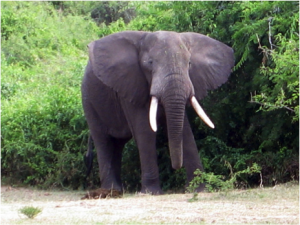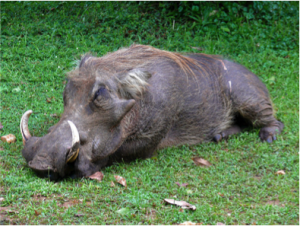Do you brush your teeth every day? Can you imagine how long it would take to brush your teeth or the giant toothbrush you would need to brush an elephant tusk?! Elephants aren’t the only creatures with big teeth called tusks. Come with me, Jungle Jim, on an adventure as we discover animals with tusks.
Elephants
 Elephants may be the animals most famous for having tusks. There are only two types of elephants; the African elephant and the Asian Elephant. Boy and girl African elephants have tusks, while only boy Asian elephants have tusks.
Elephants may be the animals most famous for having tusks. There are only two types of elephants; the African elephant and the Asian Elephant. Boy and girl African elephants have tusks, while only boy Asian elephants have tusks.
Elephant tusks are made of ivory and are very strong. Their tusks never stop growing and can become very large. Elephants use their tusks for digging, looking for food, fighting other elephants, protecting from predators and moving things out of the way. Some elephants have even been trained to move heavy logs with their tusks.
Do you use your right hand or left hand more? Similar to people, elephants choose a tusk that they like to use the most. The tusk they use most often is called the master tusk.
Warthogs
 Warthogs are large wild pigs that live throughout Africa. They are specially adapted to survive in places that are hot and dry. They can go a very long time without drinking water.
Warthogs are large wild pigs that live throughout Africa. They are specially adapted to survive in places that are hot and dry. They can go a very long time without drinking water.
They are called warthogs because they have large thick warts on their faces. Warthogs are also known for their tusks. They have two upper tusks that jut out from the sides of their mouth. They are the shape of a large C. They also have two smaller, very sharp tusks on the bottom. They use their tusks to defend themselves against predators like lions. They duck into an underground hole to make themselves hard to reach and then use their tusks to protect themselves.
They also use their tusks to dig for roots and tubers that they like to eat.
Wild Boar
Wild boar live in forests in Europe, Asia and a small part of Africa. They like to live in places that are very thick with plants so they can hide and have plenty to eat.
Wild boars have tusks that jut up from the bottom of their mouths. The boy wild boars also have a tusk on their top lip that is always working to sharpen their bottom tusks. Like the warthogs, they use their tusks to dig for food and to protect themselves.
Walrus
Walruses live in very cold water in the arctic circle. They are very large and covered in thick fat to keep their bodies warm. They have two really big tusks that hang down from the top of their mouths. They use these tusks to break through the ice and to pull themselves onto land from the water. They also use their tusks to help decide which walruses should be in charge of the group.
Walruses also have thick whiskers that look like a mustache over the top of their mouths. They use their whiskers to feel for food in the dark ocean waters.
Narwhal
Narwhals may have the most unusual tusk of all. It is a tooth that juts out of its head and looks a lot like a horn. Narwhals live in cold and icy waters in the ocean, so they use their tusks to drill through the ice. Narwhals also cross tusks, similar to a sword fight. Scientists don’t know exactly why narwhals do this, but they think it might be a friendly way to communicate or a way to clean their tusk.
Narwhals live in pods of up to 100 and migrate from shallow water in the summer to ice packed, deeper water in the winter.
Unique Adaptations
All of these incredible creatures use their tusks to survive in their special habitats. They all look different and use the tusks for different tasks. Tusks are just one unique and special feature that these creatures have. Can you think of other special features that help these animals survive? To learn more about special animals and their fun characteristics come sing with me, Jungle Jim!
Sources
“Basic Facts about Narwhals” Defenders.org
